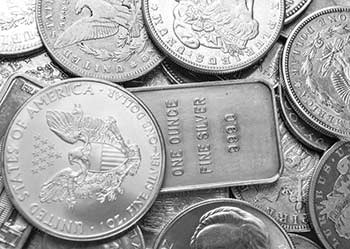Forecasting Silver Prices: What Are the Most Important Variables?

As of this morning, silver is looking like it may end the week on a high note. It’s been a relatively stable week for precious metals, which has given us some time to collect or breaths and wonder where commodities like gold and silver might be moving. And that in turn lets us review some of the most important variables that affect these prices.
In order to forecast the price of silver, let’s zoom out from the stability of this week and look for the long-term trends that really matter. Here are some of the most important economic variables that impact the price of silver:
The U.S. Dollar
Perhaps the most important variable there is for precious metals. Because silver and gold are denominated in U.S. dollars, there’s some simple arithmetic going on here: the stronger your dollars are, the more silver you can buy—which means that silver is cheaper. The weaker your dollars are, the less silver you can buy—silver becomes more expensive. The U.S. dollar isn’t limited to impacting just these precious metals, but it’s always one of the most fundamental economic indicators to look at, especially as it correlates to these commodities.
To closely monitor the U.S. Dollar Index, bookmark MarketWatch’s DXY page. You’ll be amazed at how often the DXY and silver seem to work inversely from each other.
Federal Reserve Interest Rate Targets
Although this subject is debatable, there’s a general feeling out there that lower Federal Reserve interest rate targets will mean more money is flowing, which in turn can lower the strength of the U.S. dollar and drive up the price of commodities or investments which include anything from real estate to precious metals. As is the case with the U.S. Dollar index, this is one of those variables that matters to all sorts of market sectors—not just precious metals.
Supply and Demand
Silver and gold are subject to basic economics as any other commodities are. In forecasting the price of something like silver, it’s important especially to watch global demand (for example, there was a recent suggestion of a bump in silver demand, and we have since seen higher prices). There are macro and microtrends here. Macro trends in silver relate to its use in industry, electronics, and medicine as the economy continues to involve. Micro trends tend to be more seasonal and month-by-month, as we saw just this month.
Gold
Silver tends to follow the price of gold over time. The two are the same asset class, after all, and there’s generally a feeling that the price of silver will tend to stick to a general ratio to the price of gold. Some investors use this ratio to gauge whether or not silver is underperforming. Currently, the ratio stands at approximately 73:1, which suggests that there may be some long-term room for sliver to improve.
Housing
You wouldn’t think it, but silver and copper can be closely linked to the demand for housing, as Investopedia notes.
If you watch all of these factors, then forecasting the price of silver may not always be 100% accurate—but you will get a better idea of which way the winds are heading. The trick is in combining all of these elements and understanding the unpredictability of the markets.


















